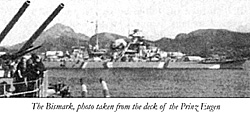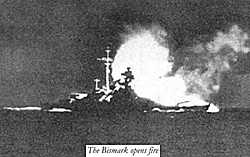 The Bismark, photo taken from the deck of the Prinz Eugen
The Bismark, photo taken from the deck of the Prinz Eugen
SEEKRIEG is a complex tabletop naval war simulation. It is suitable for any scale of miniatures, and covers the period 1890 to 1945.
There is no points system used in the game, so it is up to the players to do a little historical research, or to be creative, and come up with scenarios to suit the ships which they have available. Because of this, it can seem at times to be unbalanced, making this a game suited to long term campaigns, or historical re-enactments, rather than competition play.
An exhaustive listing of vessels, from destroyer class up, complete with quite technical data on each, provides the 'train spotters' amongst us with enough details to make for bed-wetting excitement, and for the rest of us, makes the large amount of book-keeping within the game a little easier. Stats for other vessels can be created, with a little effort, allowing the use of frigates, corvettes and small coastal craft. Some checking up in 'Jane's' or 'Conway's' is needed to provide detail to use with the submarine rules, though for surface forces, the rules are ready to go, with only a small amount of pre-game preparation necessary. Record sheets for each ship are filled out to include (among other details), length, speed, displacement, armament (from main batteries to the smallest AA guns), ammunition and armour thicknesses for the major locations of the ship.
Most of the recorded details then refer to one or more of the sixty-eight (!) tables used for reference during the game. Some of them are for the strategic element (surface, airborne and radar searches), and some are simply lists (such as the list of every Radar system used by every navy, or the list - with game statistics - for every single type of torpedo developed between 1880 and 1944!). Included are charts for determining weather conditions in any sea at any time, and also sunrise and sunset at any latitude, in any month, along with twilight times (all of which have an effect on the game, with sea condition and visibility being important factors).
Much of the game, as it is on the tabletop, consists of movement of miniatures, using any of the scales provided in the rules, everything from 'game scale' designed to fit any sized action onto one or two 6' x 4' tables, to 'true scales' for miniatures of all scales from 1:1200 to 1:4800 (for 'true scale' games with plastic models, a bit of math is required).
Movement is well governed by the rules, with large ships not as manoeuvrable as their smaller counterparts, with detailed scale speeds ensuring that it is possible to avoid or outrun slower ships. Angles of fire for each gun battery and torpedo mount are taken into account, and a protractor is an essential piece of equipment , for both fire and movement.
On the subject of mathematics, this is where many would-be players run screaming. Every shot in a turn (two minutes) requires the use of a brain, or a calculator. Much information must be taken into account for each shot, from target size, speed, range and bearing, to the quality of the firer's gun direction and Radar, as well as weather conditions, over-concentration of fire, evasive manoeuvres, smoke and spotter aircraft. As for torpedoes, any system which has to include a chart of sine values for the torpedo equation is getting fairly complicated in anyone's book. All this number crunching does have a purpose though. It reduces all the large numbers which crop up in accurate simulations (a salvo of shells, a spread of torpedoes, or even an entire carrier load of Kamikaze aeroplanes), to a set of simple percentile dice rolls.
Well detailed (there's that word again) hit result tables, including damage variation by shell type, and extensive (frighteningly realistic) critical hit tables, mean that ships can withstand a pounding, while fighting on grimly (yes there is a morale/abandon ship table), or, if you're unlucky, they can catch fire and burn to the waterline, while damage control parties do their best to contain the blaze. Results such as that suffered by HMS Hood are possible too, and have been suffered by several ships.
 The Bismark opens fire
The Bismark opens fire
With a little familiarity and practice, anyone can grasp the concepts, and the maths, involved in this game, and play can proceed quite quickly. An engagement such as the Battle of the River Plate (Admiral Graf Spee versus HMS Ajax, Achilles and Exeter) can be played in one evening, and larger battles (Jutland anyone?) with several players to a side could be finished in less than one weekend. This system would lend itself ideally to large multi-player 'double blind' games, with admirals separated from the table, giving orders to their subordinates, without having a 'bird's-eye' view of the action. Overall, this is a very complicated, very detailed, reasonably realistic simulation of naval warfare, and although it takes a while to become familiar with the rules, and there is a lot of number crunching involved, I heartily recommend it to any wargamer who seeks a little more than the over-simplified sets of miniatures r ules which are gaining such popularity.
SEEKRIEG Fourth Edition
by Richard R. Sartore and Jack L. Joyner.
Published by XENO Games (USA).
Back to Table of Contents -- Kriegspieler #7
To Kriegspieler List of Issues
To MagWeb Master Magazine List
© Copyright 1999 by Kriegspieler Publications.
This article appears in MagWeb (Magazine Web) on the Internet World Wide Web.
Other military history articles and gaming articles are available at http://www.magweb.com